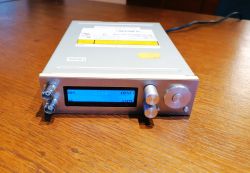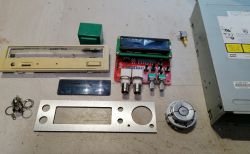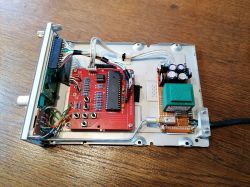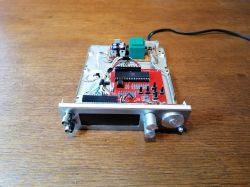FAQ
TL;DR: Re-casing a €12 Chinese DDS generator in a CD-ROM box delivers ±1 Hz frequency agreement and “very respectable” stability [Elektroda, dudik56, #19258591; Elektroda, kapi11711, #19259677] while upgraded wiring adds 3-core 0.5 mm² cable and ≥6 mm 230 V spacing.
Why it matters: Smart safety and layout tweaks turn a bare board into a reliable lab signal source for pennies.
Quick Facts
• Frequency span: 0.01 Hz – 10 MHz typical for AD9850/AD9833 Chinese DDS boards ("DDS Function Generator").
• Accuracy: ≤ 1 Hz deviation at 1 kHz vs. counter [Elektroda, dudik56, post #19258591]
• Output swing: 0 – 20 Vpp selectable with onboard op-amp [“H11887 install manual”].
• Mains section: 2 × 12 V, 2.5 VA transformer, 63 mA fuse [Elektroda, dudik56, post #19259195]
• Safety clearance: 6 mm PCB-to-case gap after fix [Elektroda, dudik56, post #19259195]
1. Which DDS board is used and what range does it cover?
The build uses the common H11887/AD9850 DDS module. Its sine, square and triangle outputs span approx. 0.01 Hz to 10 MHz, with 0.01 Hz resolution according to the kit datasheet [“H11887 install manual”].
2. How precise is the frequency output?
At 1 kHz the module’s display and an external counter differed by no more than 1 Hz, giving a 0.1 % error budget [Elektroda, dudik56, post #19258591]
3. How can I eliminate offset or crossover distortion in the waveform?
Replace the stock LM358 with TL062; users reported a smooth zero-crossing after the swap [Elektroda, dudik56, post #19261095] “It’s not offset, rather cross-distortion” clarifies a peer [Elektroda, zgierzman, post #19261128]
4. What power-supply topology was chosen?
A 2 × 12 V, 2.5 VA PCB transformer feeds LM7812, LM7912 and LM7805 linear regulators, yielding +12 V, –12 V and +5 V rails [Elektroda, dudik56, post #19257919]
5. How do I route 230 V safely inside a metal case?
Keep live traces ≥ 6 mm from metal, insulate the standoffs, and use a rear power switch to shorten mains wiring [Elektroda, dudik56, #19259195; Elektroda, ^ToM^, #19259830].
6. Is a protective-earth (PE) conductor mandatory here?
For Class II, low-power gear PE is not obligatory, yet many builders add a 3-core cable for extra safety [Elektroda, U92, post #19260986] The author later swapped to a 3-core 0.5 mm² lead [Elektroda, dudik56, post #19263396]
7. Which power switch fits a shallow front panel?
A miniature PCB switch actuated by a long plastic rod lets you mount mains components at the rear while retaining a front button, a practice used by Philips and Hameg instruments [Elektroda, ^ToM^, post #19259830]
8. How can I turn an old optical-drive shell into a lab case?
How-To:
- Strip the DVD-ROM, keep the steel frame and aluminium front.
- Mill openings for BNCs, display and keypad; bond a Dibond overlay for labels.
- Mount boards on plastic standoffs and close with retained screws. Total time: ≈ 2 h [Elektroda, dudik56, post #19257919]
9. What mains cable and fuse ratings should I choose?
Match fuse to worst-case short-circuit. The build uses a 63 mA glass fuse and a 3-core 0.5 mm² cable, providing > 4× thermal headroom [Elektroda, dudik56, post #19261660]
10. Can I obtain continuous frequency tuning instead of decade steps?
Standard firmware steps digitally; for audio sweeps you can add an encoder-driven “fine” menu or upgrade to an AD9834 board offering 0.004 Hz resolution [“DDS Function Generator”].
11. What are common failure or hazard edge cases?
Edge cases include standoff creep reducing clearance below the IEC 61010 5.5 mm minimum, and a loose live wire touching the case, causing shock risk. A 3-core cord and strain-relief clamp mitigate both issues [Elektroda, pawlik118, post #19259133]
12. Where can I get full schematics and code?
Download the original PDF manual from Dropbox [Elektroda, dudik56, post #19258791] or check the open-source design on Electronics-Lab (“DDS Function Generator”).








Comments
Interesting design, although I would have reservations about these protruding display frames. It breaks down all the aesthetics. [Read more]
These protruding frames are in my earlier devices, I was already rolled over for these frames ;) that's why I didn't make this mistake this time and the display is too fast. [Read more]
I have to clean up my DDS, and the idea of an optical drive box is a great idea. Plus for that. [Read more]
I like it very much. I like it this way. The device is not a Christmas tree to watch, but something that is often exposed to accidental damage while working. this case certainly meets this condition. By... [Read more]
As for such a cheap, I am amazed by its indications, they coincide to 1Hz. I temporarily connected the oscilloscope and both devices show the same ;) https://obrazki.elektroda.pl/7904436300_1613407392_thumb.jpg... [Read more]
that's great :) And can you tell me what the generation range is? [Read more]
It's a well-known construction, see the description here https://www.dropbox.com/s/z0ktc666sct1gj1/H11887install.pdf?dl=0 and here https://www.electronics-lab.com/project/dds-function-generator/ ... [Read more]
Thanks for the links :) I have already tracked the Chinese and I will make a housing similar to yours. [Read more]
But maybe security is more concerned than the author of the thread. 230 VAC fits onto a universal unit hanging millimeters above the metal casing. Well, some piece of paper underneath ... And the protective... [Read more]
Thanks for your vigilance ;) I've thought about it too, but it's not too bad ;) There is quite a thick plastic plate on the spacers under the entire plate of the power supply, not a piece of paper,... [Read more]
Well, but from the place where the blue wire is soldered to the board, and the mounting screw to the housing is maybe ... with 0.5mm? And it should be 10mm. The switch is also probably not adapted to ... [Read more]
The switch is really delicate, but with a 2.5W transformer, its load current is around 10mA and it works fine, I had trouble finding a sufficiently small fuse ;) The distance of the cable is 6mm and it... [Read more]
As for the switch, I meant the operating voltage - in terms of insulation to the metal button rod. [Read more]
I understand, I can roll a plastic rod connector and switch, it's 5 minutes of work ;) I'll think about it again. Thanks for your comments. I corrected, the distances higher and insulated, I... [Read more]
Personally, this type of housing does not appeal to me (I have been against upcycling for some time), but overall it looks really neat and I believe that the author likes it, a plus. The second - a very... [Read more]
Nice. Plus from me for making a power switch with a long pusher. A solution known from factory equipment (Philips or Hameg). This allows you to move away with the power supply and power switch and 230... [Read more]
Not only. For me, this generator lacks a smooth frequency change, which in the case of "digital" waveforms does not bother me, but in the audio range (eg 20Hz-20kHz) it would be useful. [Read more]
I am not sure whether it is in the case of a metal housing, where theoretically there may be potential on the elements susceptible to touch obligatory is to route the protective conductor and ensure... [Read more]
Very nice neat workmanship, fits nicely with the rest of the equipment. A plus for aesthetics. [Read more]